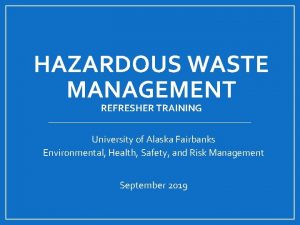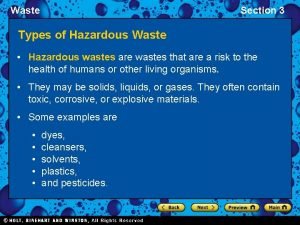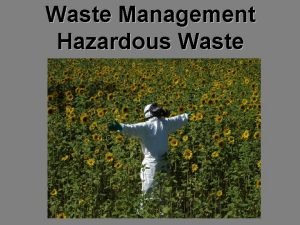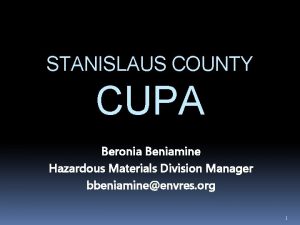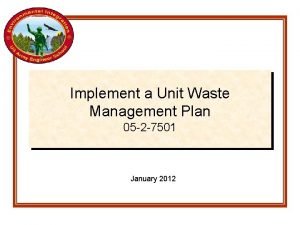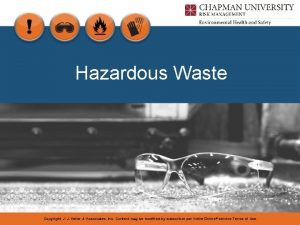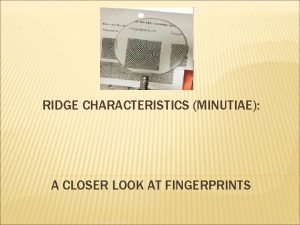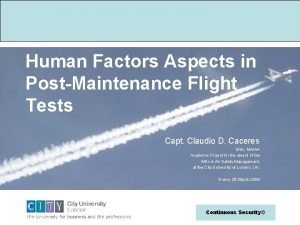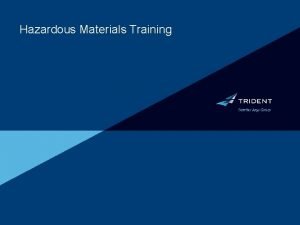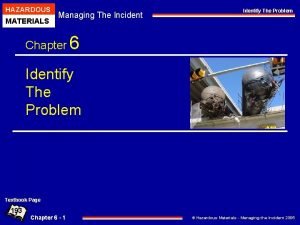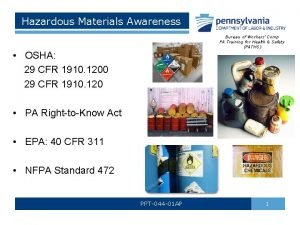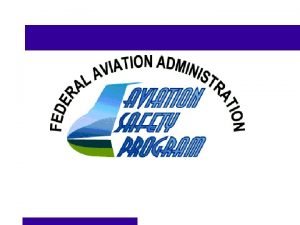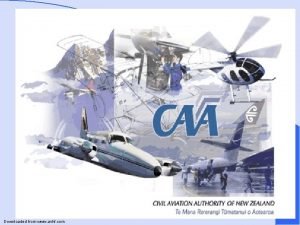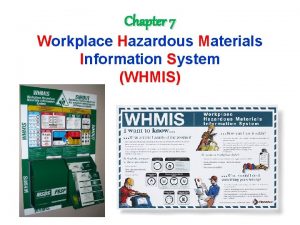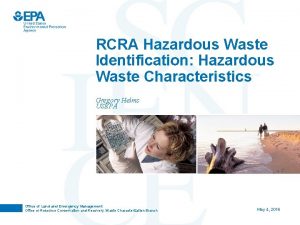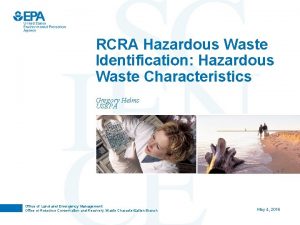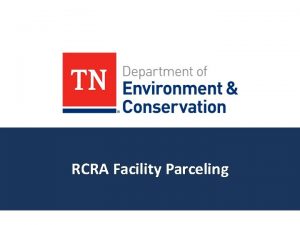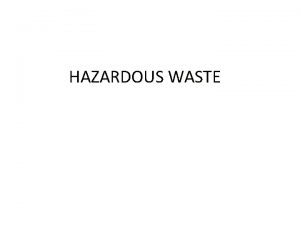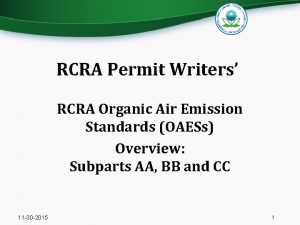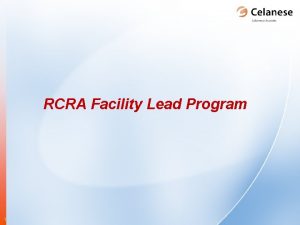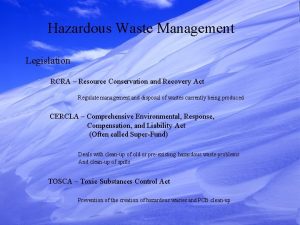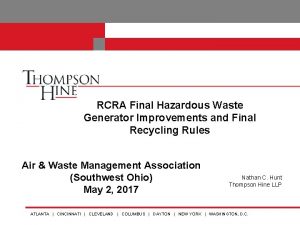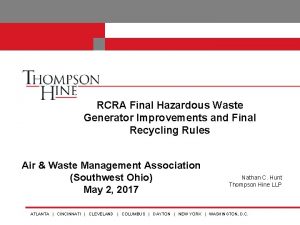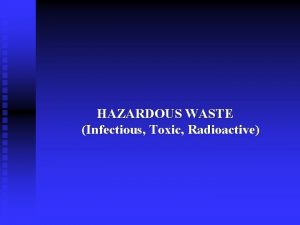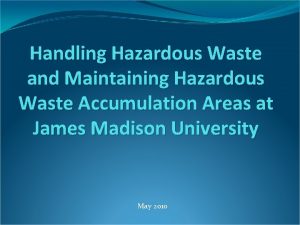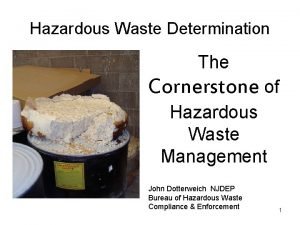RCRA Hazardous Waste Identification Hazardous Waste Characteristics Gregory


















- Slides: 18

RCRA Hazardous Waste Identification: Hazardous Waste Characteristics Gregory Helms USEPA Photo image area measures 2” H x 6. 93” W and can be masked by a collage strip of one, two or three images. The photo image area is located 3. 19” from left and 3. 81” from top of page. Each image used in collage should be reduced or cropped to a maximum of 2” high, stroked with a 1. 5 pt white frame and positioned edge-to-edge with accompanying images. Office of Land Emergency Management Office or Resource Conservation and Recovery, Waste Characterization Branch May 4, 2016

What Waste is Hazardous? • First, a material must be a solid waste under RCRA. • Waste may be classified as hazardous by being listed or because it exhibits a hazardous characteristic. § 261. 3(a)(2). • RCRA Hazardous Characteristics are: – Ignitable – Corrosive – Reactive – Toxicity Characteristic • Evaluation is based on generator knowledge if there is no test in the regulation. • Evaluation is based on testing a representative sample where a regulatory test exists (but knowledge may also be used). Office of Land Emergency Management Office of Resource Conservation and Recovery, Waste Characterization Branch 1

Hazardous Characteristics • Ignitability: D 001 (40 CFR 261. 21) • There are 4 categories of waste regulated as ignitable: • Liquids: Based on flash point test – Flashes at temperatures less than 60 degrees C (140 F) – Does not apply to aqueous solutions containing less than 24% alcohol – Example: organic solvents, light oils • Solids: Narrative definition: – A non-liquid capable of causing fire through friction, absorption of moisture, or spontaneous chemical changes, and when ignited burns so vigorously and persistently that it creates a hazard. – Example: White or red phosphorous Office of Land Emergency Management Office of Resource Conservation and Recovery, Waste Characterization Branch 2

Hazardous Characteristics • Compressed gases: Test and numerical criteria – The material is under pressure: in a container, an absolute pressure exceeding 40 psi at 70 °F or, regardless of the pressure at 70 °F, having an absolute pressure exceeding 104 psi at 130 °F, or any liquid flammable material having a vapor pressure exceeding 40 psi absolute at 100 F – A mixture of 13 percent or less with air forms a flammable mixture or the flammable range with air is wider than 12 percent regardless of the lower limit. – Example: many aerosol cans • Oxidizers: Narrative definition – a substance such as a chlorate, permanganate, inorganic peroxide, or a nitrate, that yields oxygen readily to stimulate the combustion of organic matter – An organic compound containing the bivalent -O-O- structure and which may be considered a derivative of hydrogen peroxide – Example: perchlorate (makes up 70% of space shuttle solid rocket; -Cl-O 4 ); sodium hypochlorite (household bleach; Na-Cl-O); airbag igniters, airliner O 2 – According to a 2002 FEMA report, there are thousands of landfill fires annually. Office of Land Emergency Management Office of Resource Conservation and Recovery, Waste Characterization Branch 3

Hazardous Characteristics • Corrosivity: D 002 (40 CFR 261. 22) • Aqueous wastes: p. H Testing – It is aqueous and has a p. H less than or equal to 2 or greater than or equal to 12. 5, as determined by a p. H meter using method 9040 C. • Liquid wastes: Coupon Test – Corrode steel at a rate greater than 6. 35 mm per year at a test temperature of 55 C, using Method 1110 A. • Non-aqueous wastes not included; there are several methods used in practice for determining whether a waste is aqueous. – Pressure/vacuum filtration as in the TCLP test – Paint filter test (not always reliable). – Quantitative tests for water content (e. g. , Karl Fisher test). Office of Land Emergency Management Office of Resource Conservation and Recovery, Waste Characterization Branch 4

Hazardous Characteristics • Reactivity: D 003 (40 CFR 261. 23) • The eight sub-parts all have narrative definitions. – (1) It is normally unstable and readily undergoes violent change without detonating. • Example: white phosphorous; spent petroleum catalyst – (2) It reacts violently with water. • Example: aluminum dross, metallic sodium – (3) It forms potentially explosive mixtures with water. • Example: Magnesium generates H 2 in contact with water. – (4) When mixed with water, it generates toxic gases, vapors or fumes in a quantity sufficient to present a danger to human health or the environment. • Example: phosphorous in contact with water (to prevent its reaction with the air) generates phosphine gas. Office of Land Emergency Management Office of Resource Conservation and Recovery, Waste Characterization Branch 5

Hazardous Characteristics • Reactivity: D 003 (40 CFR 261. 23), continued • (5) It is a cyanide or sulfide bearing waste which, when exposed to p. H conditions between 2 and 12. 5, can generate toxic gases, vapors or fumes in a quantity sufficient to present a danger to human health or the environment. – (6) It is capable of detonation or explosive reaction if it is subjected to a strong initiating source or if heated under confinement. • Example: confiscated recreational or display fireworks – (7) It is readily capable of detonation or explosive decomposition or reaction at standard temperature and pressure. – (8) It is a forbidden explosive as defined in 49 CFR 173. 54, or is a Division 1. 1, 1. 2 or 1. 3 explosive as defined in 49 CFR 173. 50 and 173. 53. • Examples of DOT Divison 1. 1: Trinitrotoluene (TNT), Picric acid, RDX; includes devices containing these chemicals too. Office of Land Emergency Management Office of Resource Conservation and Recovery, Waste Characterization Branch 6

Hazardous Characteristics • Toxicity Characteristic (TC): D 004 -D 043 (40 CFR 261. 24) • A waste is TC hazardous if it generates leachate containing any constituents at a concentration greater than or equal to the values in § 261. 24 Table 1, when tested using the TCLP test. – Excludes manufactured gas plant remediation waste – If waste contains less than 0. 5 percent filterable solids, the waste itself, after filtering using the method outlined in Method 1311, is considered to be the extract. • The TC list includes metals, solvents and pesticides Office of Land Emergency Management Office of Resource Conservation and Recovery, Waste Characterization Branch 7

Generator Hazardous Waste Determinations • 40 CFR 262. 11: Generators must determine whether their waste is RCRA hazardous, using either testing or generator knowledge. – For potentially characteristic waste, parts of the regulations have tests defining whether a waste is hazardous, while other parts do not. For example: • TC regulation uses the TCLP test • The oxidizer part of ignitability is a narrative definition. – Even where there is a test, the generator may still use knowledge. • For example, a low total concentration of TC constituents may mean that the waste could not fail the TCLP test. • However, if there is a defining test, inspectors will usually use it. Office of Land Emergency Management Office of Resource Conservation and Recovery, Waste Characterization Branch 8

Hazardous Waste Determinations • Hazardous waste determinations must be made at the point of generation, before any mixing or dilution. • The hazardous characteristics may apply to waste at any stage of management. That is, a solid waste is a hazardous waste whenever it exhibits one or more of the hazardous characteristics. – Some wastes may change their properties in the course of handling and either lose or acquire a hazardous characteristic: • Mixtures, suspensions, or emulsions may separate into distinct phases. • Contact with ambient air may reduce the p. H of some wastes, which may change their leaching properties or other properties. – Generators should know when such changes may occur. Office of Land Emergency Management Office of Resource Conservation and Recovery, Waste Characterization Branch 9

Hazardous Waste Determinations: Testing • The results of regulatory tests, when properly performed, are definitive in making a hazardous waste determination. • Non-regulatory tests may nonetheless provide information on the properties of a waste, and can be considered knowledge. • All testing needs to be performed on a representative sample of the waste. – For some heterogeneous wastes, getting a representative sample may be difficult: • Lead-paint debris • Ewaste • Some wastes may change with changes in feedstock or manufacturing process, or may vary seasonally, and need reevaluation. Office of Land Emergency Management Office of Resource Conservation and Recovery, Waste Characterization Branch 10

Generator Hazardous Waste Determinations • Where there is no defining test, generators must use knowledge of their waste and the regulations to make a determination. Knowledge may include: – Manufacturing/engineering process knowledge or mass balance. – Non-regulatory testing that can illustrate properties of the waste (e. g. , totals testing, DOT/UN-TDG/OECD tests of properties) – Damage cases attributable to the waste. – Knowledge of the chemical constituents in the waste. – Knowledge of similar wastes or waste constituents. – Classification by other agencies or third party technical organizations (e. g. , DOT or NFPA) in hazard categories overlapping RCRA hazardous characteristics. Office of Land Emergency Management Office of Resource Conservation and Recovery, Waste Characterization Branch 11

Hazardous Waste Determinations Based on Knowledge • Generator knowledge: Any relevant and reliable (verifiable) information source can be used. – Generator may need to demonstrate relevance. • Information should be organized to illustrate how it supports conclusions. • Usually no single piece of information by itself can be considered definitive (except damage clearly attributable to the waste): – Must consider all relevant information: both supportive and adverse information – In the end, make a judgement • Determinations must be accurate! Office of Land Emergency Management Office of Resource Conservation and Recovery, Waste Characterization Branch 12

Hazardous Characteristics: TCLP • Knowledge of the Waste may be used even if there is a regulatory test • Total constituent concentrations may be used in some cases to make a TC determination: – The TCLP leach test uses 2 liters of leaching fluid and 100 g test material. – Therefore, there is a 20 x dilution of the total concentration of any waste constituent in conducting the TCLP test. – So, any waste having total concentration values of TC constituents that are less than 20 x the TC value cannot fail the TC even if 100% of the constituent were to leach out. – Wastes with more than 20 x the TC value may be hazardous and need further evaluation. – The 20 x approach applies only if there is no liquid in the waste. Office of Land Emergency Management Office of Resource Conservation and Recovery, Waste Characterization Branch 13

Knowledge-based Hazardous Waste Determinations • Try to understand the properties of the waste as a whole, as well as understanding the properties of its constituents. • What information do you need? – Obviously it depends on the waste, but: • Waste constituents; total concentrations • Physical/chemical properties of waste constituents: e. g. , flash point, p. H, potential for reactivity, etc. • Feedstock chemicals and manufacturing process information. Office of Land Emergency Management Office of Resource Conservation and Recovery, Waste Characterization Branch 14

Knowledge-based Hazardous Waste Determinations • Where can you find information? – The generator: even for wastes they classify as non-hazardous, they should know why (they believe) the waste is not hazardous. – Do your own research: • Standard chemical information resources: CRC handbook of chemistry & • • Physics; Merc Index MSDS/SDS (for chemical information, NFPA & DOT classification) REACH ? Patents Chemical engineering texts/Kirk-Othmer NFPA Guidance (404) DOT Haz Mat list: 49 CFR 172. 101 Published research Office of Land Emergency Management Office of Resource Conservation and Recovery, Waste Characterization Branch 15

Hazardous Waste Regulation • Waste excluded from hazardous regulation even if they meet regulatory definitions (261. 4 (b)): – Bevill wastes: mining overburden, oil & gas E & P waste, ore/mineral processing/beneficiation waste. – Some CR+3 waste – Arsenical treated wood used for its intended purpose – Lab test sample or treatability study samples – Others • Some legitimately recycled wastes • Medical Waste: no federal regs; regulated by states. Office of Land Emergency Management Office of Resource Conservation and Recovery, Waste Characterization Branch 16

Mixture and Derived From Rules • Under 40 CFR 261. 3 (b)(3), a waste, including a waste mixture, becomes hazardous when it exhibits any of the hazardous characteristics. – Therefore, characteristic wastes mixed with another waste are characteristic only if they continue to exhibit a hazardous characteristic. • Under 40 CFR 261. 3(d)(1), wastes that exhibit a hazardous characteristic at the point of generation, but not when disposed, may still be obligated to meet the 40 CFR Part 268 LDR requirements (including UHC requirements). Office of Land Emergency Management Office of Resource Conservation and Recovery, Waste Characterization Branch 17
 Alaska hazmat training
Alaska hazmat training Section 3 hazardous waste answers
Section 3 hazardous waste answers Screw feed technology of waste management
Screw feed technology of waste management Hazardous waste apes
Hazardous waste apes Example of hazardous waste
Example of hazardous waste Stanislaus county hazardous materials division
Stanislaus county hazardous materials division Waste management references
Waste management references Solid and hazardous waste
Solid and hazardous waste Keller hazardous waste disposal
Keller hazardous waste disposal Positive identification
Positive identification Ridge-type minutiae
Ridge-type minutiae Aviation hazardous attitudes
Aviation hazardous attitudes What is hazardous material
What is hazardous material Hazardous materials table
Hazardous materials table Us military marking system for hazardous materials
Us military marking system for hazardous materials Pa-psfa-hazardous materials awareness
Pa-psfa-hazardous materials awareness Avhf
Avhf 5 unsafe attitudes and consequences
5 unsafe attitudes and consequences Define whmis
Define whmis
